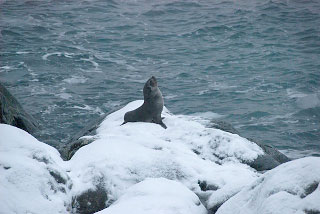

 | |||||||||
|
|
Journals 2008/2009Megan O'Neill
May 29, 2009 One of the many amazing things that can happen here at Palmer Station on a daily basis is that you might be walking between two buildings outside and you may be enjoying the beautiful scenery as you walk, off in your own little world - maybe going to do laundry or going to the lab or whatever. Then out of nowhere, you catch a glimpse of something sliding through the water - a seal! Or a penguin! Or someone leans their head out of the FEMC (Facilities Engineering Maintenance Construction) building and says, "Hey, did you see that small seal down by the seawater pump house?" In this case, it was Craig (one of the FEMC guys) leaning out to tell me. The natural wildlife around here is just the neatest experience. Fortunately I had my camera with me and went over by the water to check the little guy out. This seal was much smaller than the other fur seals that I have seen and I heard that the whale tag team members actually saw this one or one like it the week before and identified it as a "sub Antarctic fur seal." These are much smaller with the females about 4.5 feet in length and males about 6 feet in length. According to the Heard Island website (www.heardisland.aq/nature/animals/fact_file_subantarctic_fur_seals.html) the scientific name is Arctocephalus tropicalis meaning "bear-headed" and "tropical" as they were originally mistakenly though to have come from the northern coast of Antarctica. Because it is much smaller, it is easy to consider it a juvenile or young animal when in actuality it may be full grown. This little guy was adorable, and I totally wanted to be able to bring him home to be my classroom mascot. My students would flip and he would be well taken care of - although, we would have to build him a refrigeration room to deal with the heat and humidity of coastal Alabama (I think I may be onto something for my own climate adjustment needs when I return!). Unfortunately, everyone here said that it would not be possible due to the Conservation Act regulations. Darn those regulations! I did name him, "Buddy" and took lots of photos. In the lab, everyone was still buzzing around trying to get everything accomplished. After dinner, I helped Jeff sort out the samples from the -80°C freezer to prepare them for the next day. Each sample of tissue taken from the fish is in a separate plastic vial labeled with the fish number, the sample type, the date and the scientist's initials. Before the dissections begin, we label all the tiny tubes with Sharpie markers, after the tissues are inserted in the tubes during the dissection, they are dropped into liquid nitrogen to flash freeze them. Next they are sorted and put into the -80°C freezer. Once the samples are needed for the assays, they are organized quickly, as they cannot be out of the freezer for extended periods of time or it will compromise the viability of the tissue. Jeff and Lisa were working with the heart, brain and pectoral muscle tissues of the acclimated specimens from the temperature tolerance experiments.Meanwhile out on the Laurence M. Gould, we got report that the whale tag team accomplished tagging whale #9! Great news! They named this whale, "Nacho." I assume the name is because it was "Nacho ordinary whale." Apparently, several whales during the tag retrieval were very curious around the Zodiacs and really put on a performance coming all around them. A female and her calf got especially close and they got some good pictures with the calm water and almost no winds in Wilhelmina Bay. Also Meng and his team completed over 100 CTD samples! Great success all around on the LMG!
|
||||||||
